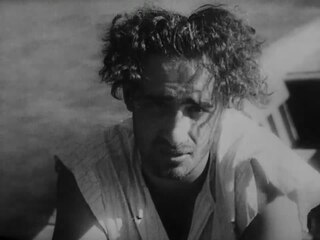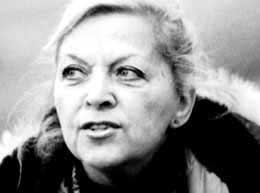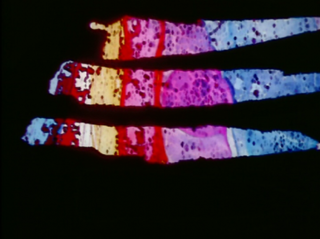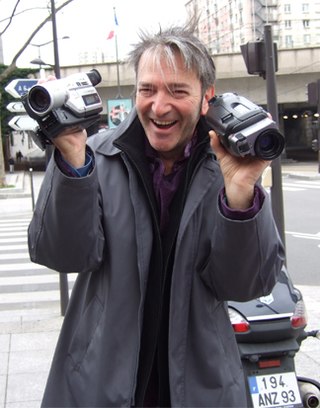Related Research Articles
Madeline Charlotte Moorman was an American cellist, performance artist, and advocate for avant-garde music. Referred to as the "Jeanne d'Arc of new music", she was the founder of the Annual Avant Garde Festival of New York and a frequent collaborator with Korean American artist Nam June Paik.
Phill Niblock is an American composer, filmmaker, videographer, and director of Experimental Intermedia, a foundation for avant-garde music based in New York with a parallel branch in Ghent, Belgium.

Experimental film or avant-garde cinema is a mode of filmmaking that rigorously re-evaluates cinematic conventions and explores non-narrative forms or alternatives to traditional narratives or methods of working. Many experimental films, particularly early ones, relate to arts in other disciplines: painting, dance, literature and poetry, or arise from research and development of new technical resources.

Shigeko Kubota was a Japanese video artist, sculptor and avant-garde performance artist, who mostly lived in New York City. She was one of the first artists to adopt the portable video camera Sony Portapak in 1970, likening it to a "new paintbrush." Kubota is known for constructing sculptural installations with a strong DIY aesthetic, which include sculptures with embedded monitors playing her original videos. She was a key member and influence on Fluxus, the international group of avant-garde artists centered on George Maciunas, having been involved with the group since witnessing John Cage perform in Tokyo in 1962 and subsequently moving to New York in 1964. She was closely associated with George Brecht, Jackson Mac Low, John Cage, Joe Jones, Nam June Paik, and Ay-O, among other members of Fluxus. Kubota was deemed "Vice Chairman" of the Fluxus Organization by Maciunas.
Su Friedrich is an American avant-garde film director, producer, writer, and cinematographer. She has been a leading figure in avant-garde filmmaking and a pivotal force in the establishment of Queer Cinema.
Peggy Ahwesh is an American experimental filmmaker and video artist. She received her B.F.A. at Antioch College. A bricoleur who has created both narrative works and documentaries, some projects are scripted and others incorporate improvised performance. She makes use of sync sound, found footage, digital animation, and Pixelvision video. Her work is primarily an investigation of cultural identity and the role of the subject in various genres. Her interests include genre; women, sexuality and feminism; reenactment; and artists' books. Her works have been shown worldwide, including in San Francisco, New York, Barcelona, London, Toronto, Rotterdam, and Créteil, France. Starting in 1990, she has taught at Bard College as a Professor of Film and Electronic Arts. Her teaching interests include: experimental media, history of the non-fiction film, and women in film.

Storm de Hirsch (1912–2000) was an American poet and filmmaker. She was a key figure in the New York avant-garde film scene of the 1960s, and one of the founding members of the Film-Makers' Cooperative. Although often overlooked by historians, in recent years she has been recognized as a pioneer of underground cinema.
Marjorie Keller (1950–1994) was an experimental filmmaker, author, activist, film scholar. J. Hoberman called her "an unselfish champion of the avant-garde."
Heinz Emigholz is a filmmaker, actor, artist, writer and producer. He lives and works in Berlin and Malta. Emigholz has produced a comprehensive filmic and artistic oeuvre and has also done performance art and acted in other directors’ films.
Takahiko Iimura was a Japanese avant-garde filmmaker and fine artist. He is considered one of the pioneers of experimental and independent filmmaking in Japan. Iimura was born in Tokyo and was a graduate of Keio University. His film Onan (1963) won the Special Prize at the Brussels International Independent Film Festival in 1964. He published a seminal work on experimental filmmaking in 1970, Geijutsu to higeijutsu no aida, and a biography of Yoko Ono, Ono Yōko hito to sakuhin, in 1985. Iimura made much of his film in New York City, but became a professor at the Nagoya Zokei University of Art & Design in 1992.
Robert Nelson was an American experimental film director.
The Treasures from American Film Archives series of DVDs is produced by the National Film Preservation Foundation (NFPF), a nonprofit organization created by the U.S. Congress in 1997. The NFPF publishes these DVD sets, with accompanying booklets and extensive commentary, to promote public access to the films preserved by the American archival community.
Leandro Katz is an Argentine-born writer, visual artist and filmmaker known primarily for his films and photographic installations. His works include long-term, multi-media projects that delve into Latin American history through a combination of scholarly research, anthropology, photography, moving images and printed texts.

Peyote Queen is an experimental short film by Storm de Hirsch, produced in 1965.
Jane Conger Belson Shimané (1927–2002) was an American experimental filmmaker.

Patrick Bokanowski is a French filmmaker who makes experimental and animated films.

Jean-Claude Mocik, was born on February 9, 1958, in Livry Gargan. He is a filmmaker, video director, a director and teacher.
Freude (Florence) Bartlett also known as Freude Solomon-Bartlett, was an American experimental film director and founder of the Serious Business Company, a San Francisco-based film sales and film distribution company known for its collection of avant-garde, animation and women's films.
Schmeerguntz is a 1965 American avant-garde film by Gunvor Nelson and Dorothy Wiley. It is a collage film that contrasts messy depictions of domestic life with the pristine images of women found in media and advertising. The film was an inspiration for the Miss America protest that happened in 1968.
My Name Is Oona is a 1969 American avant-garde short film directed by Gunvor Nelson. It uses footage of her daughter Oona that has been optically printed, with Oona's voice used for the soundtrack. The film was selected for preservation in the National Film Registry in 2019.
References
- ↑ REVOIR
- ↑ Take-Off on Fandor
- ↑ The Renegades: American Avant-Garde Film, 1960-1973|Walker Art Center
- ↑ My Name Is Oona on Fandor
- ↑ Chow, Andrew R. (11 December 2019). "See the 25 New Additions to the National Film Registry, From Purple Rain to Clerks". Time. New York, NY. Retrieved 11 December 2019.
- ↑ Jensen, Jytte. "Gunvor Nelson Retrospective: Personal Lens." Film Exhibitions 2006. 10 October 2008
- ↑ June M. Gill (Spring 1977). "The Films of Gunvor Nelson". Film Quarterly. 30 (3): 28–36. doi:10.2307/1211771. JSTOR 1211771.